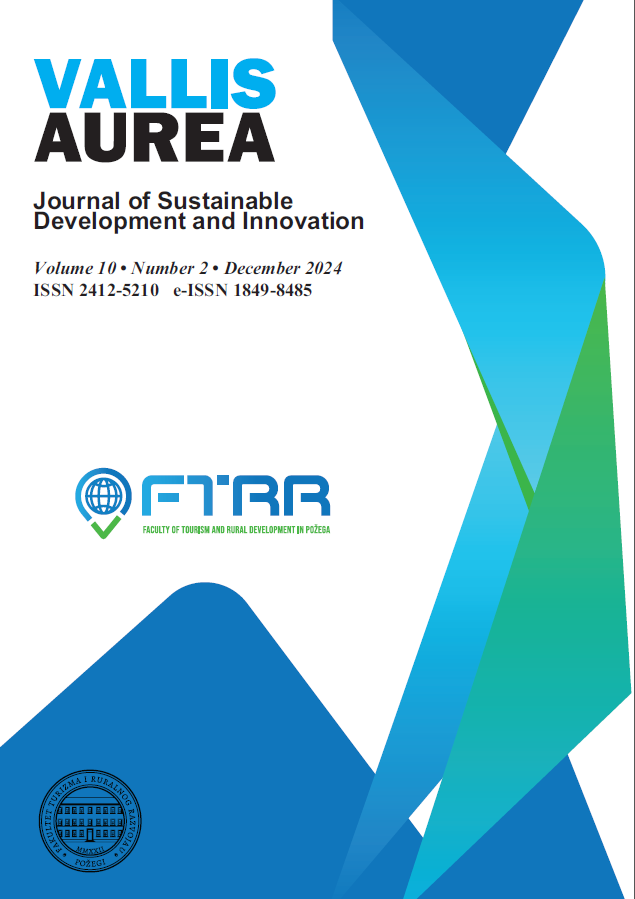Supply Chain Optimization for Environmental Sustainability
DOI:
https://doi.org/10.62598/JVA.10.2.5.10Keywords:
sustainability, supply chains, economic costs, environmental costs, dynamic programmingAbstract
This work aims to investigate the possibilities of optimizing supply chains for ecological sustainability. In the tripartite components of sustainability (economy, society, environment), economic issues are currently dominating. A model of supply chains for a sustainable future should equally embrace all three components. The purpose of the work is to promote environmental sustainability. The research results are based on the mathematical method of dynamic programming. The main finding of this paper points to the conclusion that the optimization of supply chains from the point of view of total (economic and ecological) costs is the first and most important step towards greener and ecologically sustainable supply chains.
References
1. Assefa, G. Frostell, B. (2007). Social sustainability and social acceptance in technology assessment: A case study of energy technologies, Technology in Society, Volume 29, Issue 1, pp. 63-78, https://doi.org/10.1016/j.techsoc.2006.10.007.
2. Bové, AT., Swartz, S. (2016). Starting at the source: Sustainability in supply chains, available at: https://www.mckinsey.com/capabilities/sustainability/our-insights/starting-at-the-source-sustainability-in-supply-chains, 20.12.2022.).
3. Chopra, S., Meindl, P. (2001). Supply Chain Management, New Jersey: Prentice Hall.
4. Computer Aided Chemical Engineering, Elsevier, Volume 32, pp 931-936, https://doi.org/10.1016/B978-0-444-63234-0.50156-1.
5. Cope, M.R.; Kernan, A.R.; Sanders, S.R.; Ward, C. (2022). Social Sustainability?: Exploring the Relationship between Community Experience and Perceptions of the Environment, Sustainability, 14, 1935. https://doi.org/10.3390/su14031935.
6. Crane, A., Matten, D. (2010). Business Ethics, third edition, New York: Oxford.
7. Decision Support Systems, Volume 54, Issue 4, pp 1513-1520, https://doi.org/10.1016/j.dss.2012.05.053.
8. Dobson, A. (2000). Drei Konzepte ökologischer Nachhaltigkeit. Natur und Kultur, Transdisziplinäre Zeitschrift für ökologischer Nachhaltigkeit, 1(1):62-85.
9. Elkington, J. (1994), Towards the sustainable corporation: Win-win-win business strategies for sustainable development, Calif. Manage. Rev., Vol. 36, pp. 90–100.
10. Handfield, R.B., R. Sroufe and S.V. Walton, (2005). Integrating environmental management and supply chain strategies. Business Strategy and the Environment, 14(1): 1-19.
11. Kuhlman, T., J. Farrington (2010). What is Sustainability?, Sustainability, Vol. 2, No. 11, pp. 3436- 3448.
12. Liao, Z. (2023). Supply chain optimization for environmental sustainability and economic growth. Environ Sci Pollut Res 30, 121599–121613. https://doi.org/10.1007/s11356-023-30521-9.
13. McKinsey & Company (2022). What is supply chain?, https://www.mckinsey.com/featured-insights/mckinsey-explainers/what-is-supply-chain.
14. Mefford, R. (2011). T he Economic Value of a Sustainable Supply Chain, Business and Society Review. Volume 116, Issue 1, pp. 109–143, http://dx.doi.org/10.1111/j.1467-8594.2011.00379.
15. OECD/EUIPO (2016). Trade in Counterfeit and Pirated Goods: Mapping the Economic Impact, OECD Publishing, Paris, from https://euipo.europa.eu/tunnel-web/secure/webdav/guest/document_library/observatory/documents/Mapping_the_Economic_Impact_study/Mapping_the_Economic_Impact_en.pdf.
16. Parajuli, R., Thoma, G., Matlock, M. (2019). Environmental sustainability of fruit and vegetable production supply chains in the face of climate change: A review,Science of The Total Environment, Volume 650, Part 2, pp. 2863-2879, https://doi.org/10.1016/j.scitotenv.2018.10.019.
17. Popovic, T., Kraslawski, A., Avramenko, Y. (2013). Applicability of Sustainability Indicators to Wastewater Treatment Processes, Editor(s): Andrzej Kraslawski, Ilkka Turunen,
18. Pupavac, D., Maršanić, R. i Krpan, Lj. (2021). Optimization of COVID-19-Free Supply Chains, Promet-Traffic&Transportation, 33 (2), 259-266. https://doi.org/10.7307/ptt.v33i2.3643.
19. Seuring, S. (2013). A review of modeling approaches for sustainable supply chain management,
20. Strahinja, D. (2006). Ekonomija – gdje je tu čovjek? Rijeka: Digital point.
21. T h e Economist (2008). Th e feelgood factor. URL: http://www.economist.com/node/10491069 (12. 10. 2024.)
22. Taylor, S. (2009). Environmental Crises: Past, Present and Future, Canadian Journal of Economics.
23. Vilena, V., Gioia, D. (2020). A More Sustainable Supply Chain, Harvard Business Review, March-April, Brighton, Massachusetts.
24. World Commission Environment and Development, 1987
25. Yang Q., Ji Y. (2016), The platform economy and natural monopoly: regulating or laissez-faire?, Fudan University, Shanghai.
26. Zarra, A., et al. (2019). Sustainability in the Age of Platforms, Centre for European Policy Studies (CEPS) and Academy of Internet Finance, Brussels, from https://www.ceps.eu/wp-content/uploads/2019/06/Sustainability-in-the-Age-of-Platforms-1.pdf.
Downloads
Published
Issue
Section
License
Copyright (c) 2024 Vallis Aurea

This work is licensed under a Creative Commons Attribution-NonCommercial-NoDerivatives 4.0 International License.
Authors of papers for publishing in the journal agree under a Creative Commons Attribution-NonCommercial-NoDerivatives 4.0 International License.https://creativecommons.org/licenses/by-nc-nd/4.0/







